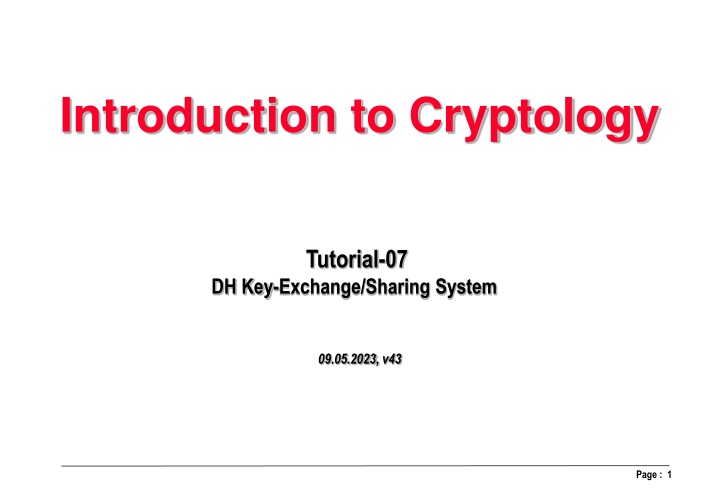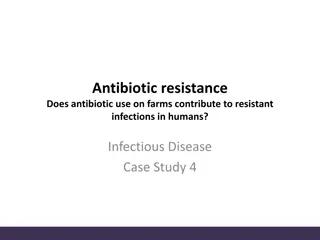Fighting Antibiotic Resistance in Spain & Hungary
"Hands-on training for farmers and veterinarians in Hungary on reducing antibiotic use, Spain's plan on AMR, strategic lines, reduction programs, and sector-specific goals to combat antimicrobial resistance effectively."
Download Presentation

Please find below an Image/Link to download the presentation.
The content on the website is provided AS IS for your information and personal use only. It may not be sold, licensed, or shared on other websites without obtaining consent from the author.If you encounter any issues during the download, it is possible that the publisher has removed the file from their server.
You are allowed to download the files provided on this website for personal or commercial use, subject to the condition that they are used lawfully. All files are the property of their respective owners.
The content on the website is provided AS IS for your information and personal use only. It may not be sold, licensed, or shared on other websites without obtaining consent from the author.
E N D
Presentation Transcript
Introduction to Cryptology Tutorial-07 DH Key-Exchange/Sharing System 09.05.2023, v43 Page : 1
Design Summary for A Basic Diffie-Hellmann (DH) Public Key Exchange System In case that you have a prime: 1. If you have a prime number p and you know how to factor (p)= p1 p2 ..pt, then use the prime p to generate GF(p). 2. Find a primitive element by checking that p1 1 and p2 1, p1p2 1 .. and pt 1 . is selected randomly. 3. Publish GF(p) and in a public directory. The system is ready for use. The strength of your system is equal to the smallest prime factor of (p). In case that you do not have a prime: 1. Select a strong prime number p such that p-1 = 2 q where q is a prime. A possible procedure is to use Pocklington s Theorem to find such a prime: - Select N = 2q + 1 where q is a large prime. Check if the resulting N is prime using Pocklington s Theorem - If N is prime, take p=N and generate GF(p) Find a primitive element in GF(p) by selecting any non-zero random value and checking if its order is p-1. The order of any element in GF(p) is a divisor of p-1=2q. That is the order can be either 1, 2, q or 2q. If 2 1 and q 1 then the order of is 2q and is a primitive element. Repeat 2 until you get a primitive element. 2. 3. Publish GF(p) and in a public directory. The system is ready for use. The procedure is simillar over the extension field GF(2m) ! Page : 2
Problem 7-1: 1. Find a primitive element to set up a DH public-key exchange system using the prime number 43. 2. Generate DH common key Zabfor two users A and B having Xa= 3 and Xb= 7 as secret keys respectively. Solution 7-1: 1. To find a primitive element in GF(43) we select randomly = 3 and check if it is a primitive element. 3 is primitive if its order is a divisor of (p) = 43 1 = 42 = 2 . 3 . 7 The order of any element is one of these divisors: 1, 2, 3, 7, 6, 14, 21 or 42 Computing the order of 3: 32 = 9 1, 33 = 27 1, 36 = 41 = -2 1, 37 = -6 1, 314 = 36 1, 321 = -1 1 => 3 is a primitive element. 2. DH Public directory: GF (43) = 3 Ya= 3Xa = 33 = 27 Yb= 3Xb = 37 = -6 = 37 Common key is Zab = (Yb)Xa= (Ya)Xb = (37)3= 321= -1 = 42 Page : 3
Problem 7-2: 1. Generating one strong prime with the prime 23 (N = 2 * 23 + 1) 2. Find a primitive element to set up a DH public-key exchange system using the generated strong prime number from exercise 1. 3. Generate DH common key Zabfor two users A and B having Xa= 24 and Xb= 2 as secret keys respectively. 4. What is the probability that a randomly selected element is a primitive element? Solution 7-2: 1. Let us try to check if N= 2 * 23 + 1 = 47 is prime. Using Pocklington s Theorem: If the following conditions hold then 47 is a prime: 1. gcd( 2(47-1)/ 23 1 , 47 ) = gcd( 22 1 , 47 ) = gcd(3,47) = 1 => is true 2. 247-1 = 1 mod 47 or in Z47 => is true 3.F = 23 > 47 => 23 > 6 => is true As all conditions hold, 47 is for sure a prime 2. To find a primitive element in GF(47) we select randomly = 2 and check if it is a primitive element. 2 is primitive if its order is a divisor of (p) = 47 1 = 46 = 2 * 23. The order of any element is one of the divisors: 1, 2, 23 or 46 Computing the order of 2: 22 = 4 1, 223 = 48 = 1 => 2 is not a primitive element ! Check another element! Page : 4
Solution 7-2 Cont.: Computing the order of 5: Possible orders are 1, 2, 23 or 46 51 = 5 1 , 52 = 25 1, 523 = 46 = -1 1 (all modulo 47) Therefore, the order of 5 must be 46 and 5 is a primitive element. which may be used in the DH public directory DH Public Directory: GF (47) = 5 Ya= 524 = -5 = 42 Yb= 52 = 25 In General The modulus in the exponent is Euler function (m) (p) = 47 1 = 46 3. Common key is Zab= (Yb)Xa= (Ya)Xb = (524)2= 548 mod 46= 548-46 = 52= 25 The number of primitive elements is (46) = (2x23) = (2-1)(23-1)= 22 Prob. of having a Primitive element = 22/46 = 47.8% 4. Page : 5
Problem 7-3: 1. Select a irreducible polynomial and a primitive element to set up a DH public-key exchange system over GF(210). 2. Generate DH common key Zabfor two users A and B having Xa= 12 and Xb= 4 as secret keys respectively. 3. What is the probability that a randomly selected element is a primitive element? Solution 7-3: 1. Let us select the irreducible polynomial for GF(210) as p(x)= x10+ x3+ 1 This polynomial is also primitive as its period is 1023 = 210 1 (see table of irreducible polynomials). The order of x is 210 1. A possible primitive element is =x = 0000000010 as its order is 210 1 = 1023 = 3 * 11 * 31. Possible elements orders in GF(210) are the divisors of 1023 = 1, 3, 11, 31, 33, 93, 341, 1023. A randomly selected element is primitive if: 3 1 and 11 1 and , 31 1and 33 1and 93 1, 341 1. Many other primitive elements can be selected as ifor which gcd(1023,i)=1, for example: x10 = x3+ 1 = 0000001001 is a primitive element x20= (x3+ 1)2 = x6+ 1 = 0001000001 is also a primitive element Page : 6
Solution 7-3 Cont.: DH Public directory: GF (210), p(x) = x10+ x3+ 1 = x = 0000000010 Ya= x12 = x5+ x2 Yb= x4 2. Public keys are Ya= x12 = x10 x2 = (x3+ 1)x2= x5+ x2 Yb= x4 Common key is Zab = (Yb)Xa= (Ya)Xb = (x5+ x2)4 = x20+ x8= x6+ 1+ x8 Zab= 0101000001 The number of primitive elements is (1023) = (3 * 11 * 31) = (3-1)(11-1)(31-1) = 600 Prob. of having a Primitive element = 600/1023 = 58.6% 3. Page : 7
Problem 7-4: A Diffie-Hellman (DH) public key exchange system uses GF(26) deploying the irreducible polynomial p(x) = x6+ x3 + 1. 1. 2. 3. 4. 5. For = x, compute ifor i = 1 to 10. What is the multiplicative order of x? Which multiplicative orders are possible for elements in GF(26)? Prove that the element = 1+x = 000011 is a primitive element. Compute the multiplicative order of 14 Use the element as a public element in the above GF(26) and compute the DH public keys Yaand Yband the shared secret key Zabfor users A and B having the secret keys Xa=42 and Xb=14. Compute the binary vectors for Yaand Yband Zabby making use of the following: 7= x5+ x2, 21 =1 + x3, 6. What is the probability of getting an element with order 21 if the element is picked up randomly from GF(26)?. 7. For any element from GF(26), compute t for which -1 = t . Compute then x-1 mod p(x) using that result. (Hint make use of the results in 1) Verify your result. Page : 8
Solution 7-4: 1. P(x) = x6+ x3+ 1 = 0 => x6= x3+ 1 x1= x x2= x2 x3= x3 x4= x4 x5= x5 x6= x3 +1 x7= x4+ x x8= x5+ x2 x9= x6+ x3= x3+ x3+ 1 = 1 x10= x => ord(x) = 9 2. Possible orders are the divisors of 26- 1 = 63 Divisors of 63 are: 1,3,7,9,21 and 63 3. (x+1)1= x+1 1 (x+1)3= (x+1)2 . (x+1) = (x2+1) . (x+1) = x3+x2+x+1 1 (x+1)7= ((x+1)3)2. (x+1) = (x3+x2+x+1)2 . (x+1) = (x6+x4+x2+1) . (x+1) = x7+x5+x3+x+x6+x4+x2+1 = x4+x+x5+x3+x+x3+1+x4+x2+1 = x5+ x2 1 (x+1)9= (x+1)7. (x+1)2= (x5+x2). (x2+1) = x7+x4+x5+x2= x4+x+x4+x5+x2= x5+x2+x 1 (x+1)21= ((x+1)7)3= (x5+x2)3 = (x5+x2)2. (x5+x2) = (x10+x4). (x5+x2) = (x+x4) . (x5+x2) = x6+x3+x9+ x6= x6+x3+x6+ x3+ x6= x3+1 1 => ord(x+1) = 63 Page : 9
Solution 7-4 Cont.: ( ) 63 63 ord 4. = = = = 14 ( ) 9 ord gcd( ( ), ) gcd( 63 14 , ) 7 ord i 5. User A: Xa = 42 , Ya = (x+1)42mod(x6+x3+1) = ((x+1)21)2= (x3+1)2 = x6+1 = x3+1 + 1 = x3 = 001000 Public directory GF(26) = x+1, P(x) = x6+ x3+ 1 Ya = x3 = 001000 Yb = x4+x = 010010 User B: Xb = 14 , Yb = (x+1)14= ((x+1)7)2 = (x5+x2)2 = x10+x4 = x4+ x = 010010 Common secret key for users A and B Zab = (x+1)42 . 14 mod 63 = (x+1)21 = x3+1 Zab= x3+ 1 = 001001 6. # of all non-zero elements: 26- 1 = 63 # of elements with order 21: (21) = (7 . 3) = 6 . 2 = 12 Pr(element s order=21) = (12 / 63) . 100 = 19.05 % Page : 10
Solution 7-4 Cont.: 7. For any element t, -1 mode 63 = -1 + 63 = 62= t t = 62 x-1 = x62= (x9)6 x8= (1 )6 x8= x8 x-1= x8= x5+ x2 Verification: x . x-1= x .x8= x9= 1(see 1) Page : 11
Homework: A Diffie-Hellman public-key exchange system is setup over GF(24) using the primitive polynomial P(x) = x4 + x + 1. Compute all exponents of x up to 15 and state the corresponding binary patterns Which one of the following elements is primitive? 0011, 1111. Select it as the primitive element for DH public directory What is the probability that a randomly selected element is primitive? Compute DH common key for two users A and B having Xa=11 and Xb=7 as secret keys respectively. 1. 2. 3. 4. (Final exam 2004) Page : 12























